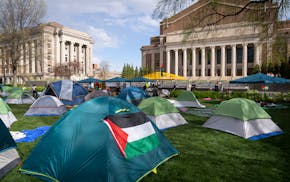A wintry walk around my south Minneapolis Whittier neighborhood is a pleasure for my partner and me, especially when the sun comes out after a fresh snow, warming the temperature and reflecting brilliantly off a new-fallen coating of white.
Our enjoyment commonly lasts until we reach what has routinely become a disappointment — arriving at Washburn Fair Oaks Park (or really almost any Minneapolis park this time of year).
You read that correctly. Our outings go south when we get to the park (you know, that most cherished shared space in the neighborhood).
The problem is that as soon as we cross Stevens Avenue on 22nd Street, arriving at the edge of the park, we are likely, if it has recently snowed, to encounter a wholly unshoveled sidewalk. You can imagine our frustration after walking past homes, apartment buildings and businesses that all (generally) clear their walks in compliance with Minneapolis code for snow removal — or really, in compliance with the simple idea of being a good neighbor.
On such occasions we cautiously trudge through the icy desire lines cut into the snow and wonder why the Minneapolis Park Board does not appear to take its responsibility as a good neighbor seriously. We commonly find the same conditions further down Clinton Avenue at Clinton Field Park, and at other parks in our neighborhood. It is rare to encounter a sidewalk around a Minneapolis park that has been cleared to the specifications called out by Minneapolis ordinance, which the rest of us property owners are expected to meet.
When I initially submitted a commentary criticizing these conditions, editors asked for specifics to substantiate that this was more than an isolated incident. So after last weekend's unexpected snowfall I visited and assessed the condition of sidewalks around nine parks in Whittier and adjacent neighborhoods. I made these observations between 10 a.m. and 11 a.m. on March 7, more than 30 hours after the end of the last snow event (4 a.m. on March 6). City ordinance requires that sidewalks be cleared within 24 hours.
Six of the nine parks I inspected had yet to have any snow removal from sidewalks. They were Washburn Fair Oaks, Clinton, Stevens Square, Kenwood, Mueller and Smith Triangle.
Two of the three parks that had clear sidewalks were staffed locations with recreation centers (Whittier and Peavey). The third with shoveled walks, Joanne R. Levin Park, is a pocket playground in the Isles neighborhood.
I can no longer abide this negligence from a publicly funded entity. It is time to make changes and focus on operating a park system that meets the bare minimum requirements of the law. Policy and practice must assure that Minneapolis parks maintain quality accessibility for our community year-round.
I have experience implementing similar changes in my work as an active transportation consultant, where I work with communities around the country that seek to achieve the highest levels of livability by planning, designing and maintaining the public right of way for people of all abilities. Such changes are implemented through thoughtful review of policy and operational protocols developed into a working plan to achieve new outcomes. If there is an inability to actualize these changes, the only recourse is to make changes in leadership and personnel.
Perhaps the Minneapolis Park and Recreation Board will find my tone terse, even bitter. That should not matter. The fact is, I am an individual who is only inconvenienced by the board's ongoing dereliction of responsibility. I am able navigate these routine barriers and carry on with my activities. But what about so many of our neighbors who are not able to overcome these obstacles? What about those whose age, physical challenges and/or lack of an automobile means they have no choice but to rely on the Park Board to remove barriers to their daily mobility needs?
How will a person using a wheelchair, or a parent pushing a stroller or a senior pulling a dolly or cart for errands navigate these sidewalks? The Park Board is a public entity using public funds and has the highest obligation to meet the needs of our community.
Maybe it is time to pump the breaks on grand new plans and efforts to update and expand the system and focus instead on boosting the quality of operations in the system we have.
Maybe instead of trying to be the best park system in the country, the board could focus on just being a good neighbor.
Tony Hull, of Minneapolis, is a transportation consultant.
![In this illustration, Greg Lukianoff, president and CEO of the Foundation for Individual Rights and Expression (FIRE). “[T]here’s a value to know](https://arc.stimg.co/startribunemedia/7RBI577EVBCE7ARENFQIVIALQ4.jpg?h=91&w=145&fit=crop&bg=999&crop=faces)
Getting back to basics on free speech
Store guns safely and save lives

Why we protested at the University of Minnesota


